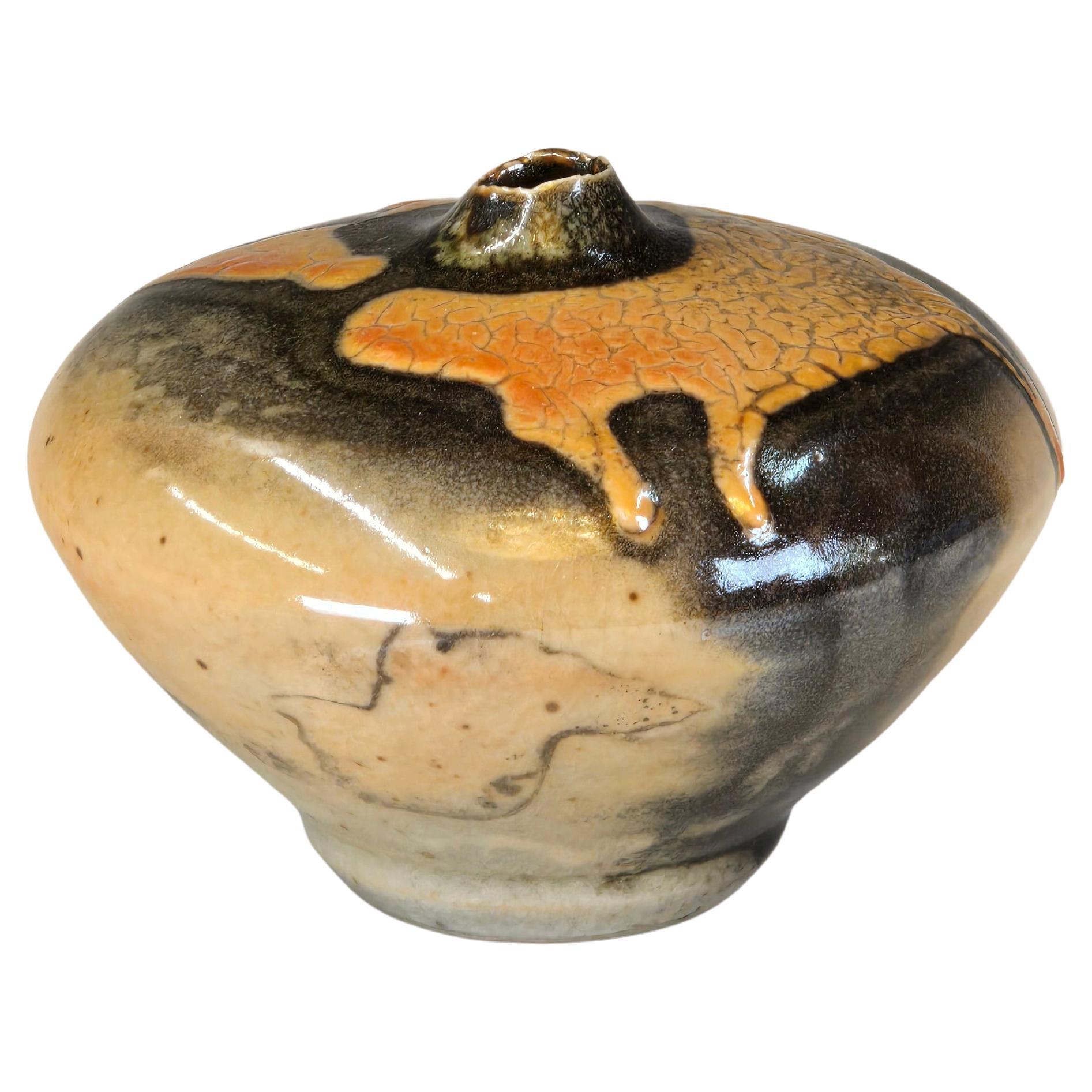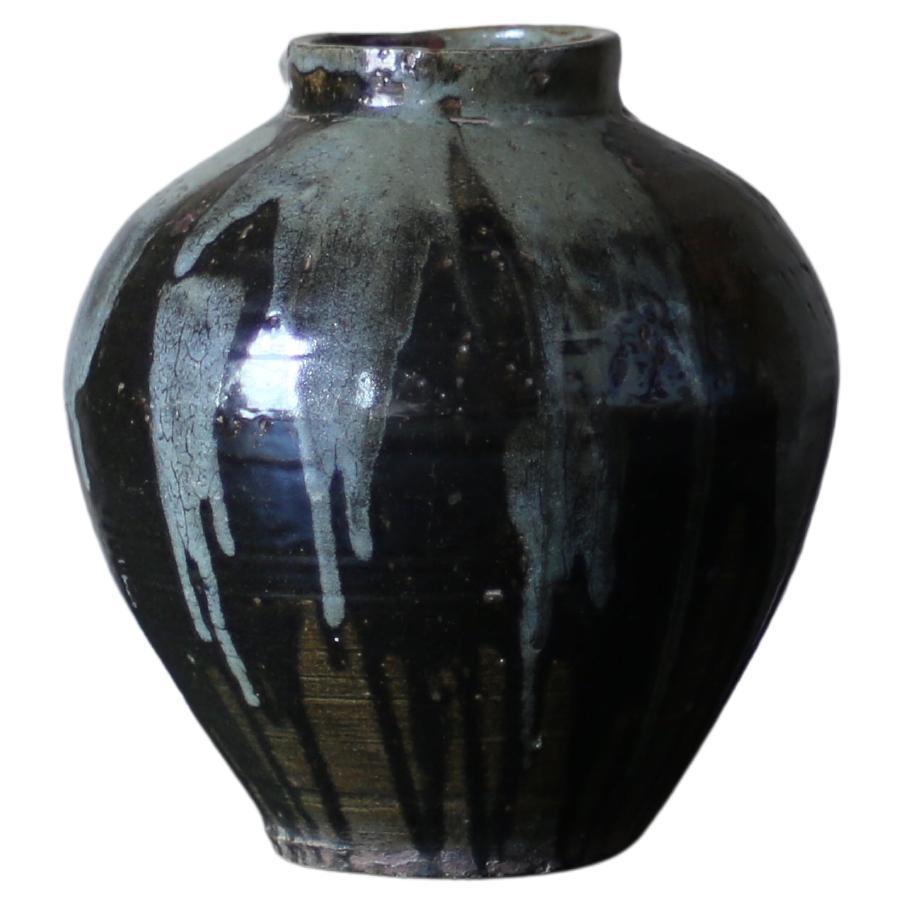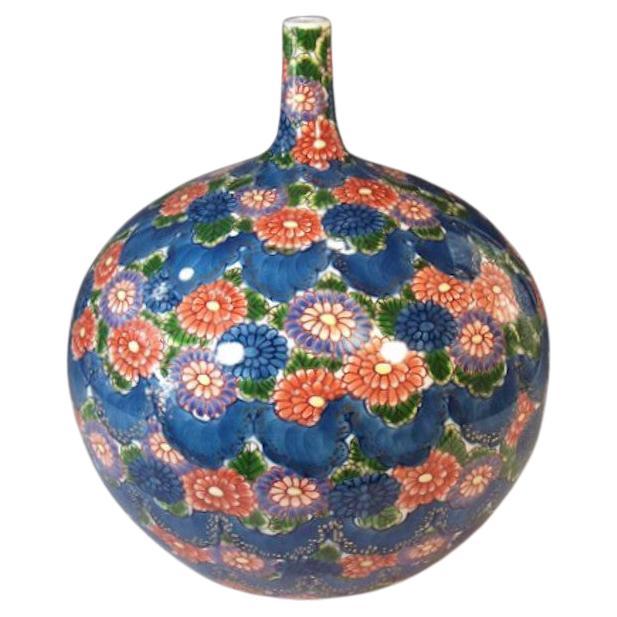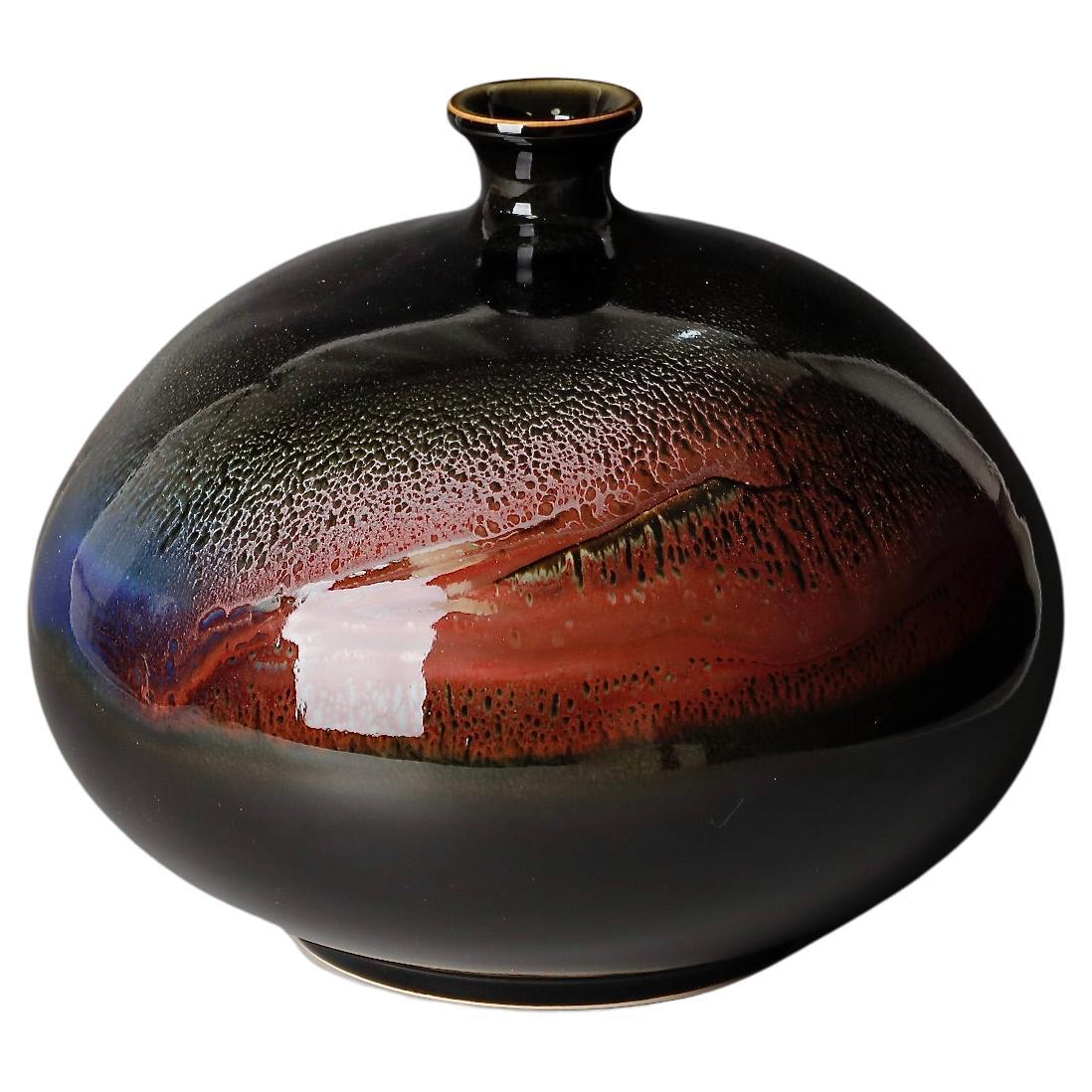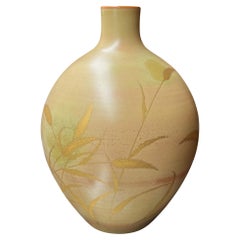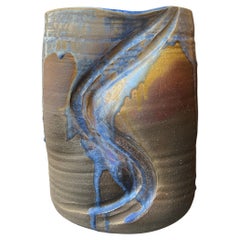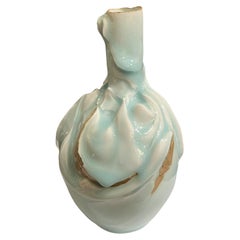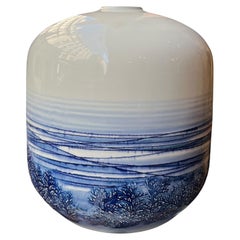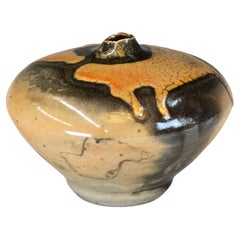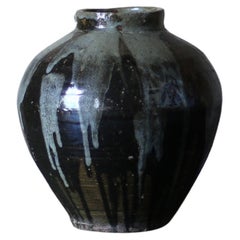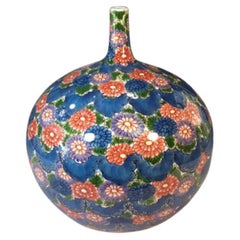Items Similar to Japan, Rare Vase by Kanzan Shinkai, born in 1912
Want more images or videos?
Request additional images or videos from the seller
1 of 10
Japan, Rare Vase by Kanzan Shinkai, born in 1912
$1,991.87
£1,500.28
€1,690
CA$2,746.88
A$3,085.99
CHF 1,612.44
MX$37,666
NOK 20,473.23
SEK 19,271.24
DKK 12,863.64
About the Item
Vase by Kanzan Shinkai,born in 1912
This vase is a fine example of Kanzan Shinkai's work. It features an intricate design, with raised circular patterns, using contrasting colors such as blue and green, typical of Shinkai's style. The circles, nested within each other, create a dynamic and unique visual effect. The surface of the vase is partially textured, which adds an extra dimension to its appearance.
Kanzan Shinkai was born in 1912, descended from a prestigious line of Kyoto artists. His grandfather, Seifu Yohei III, was a renowned potter, and Shinkai was immersed in the world of ceramics from a young age, in the heart of Kyoto's Gojo-zaka ceramic district. He was trained by his father and grandfather, before continuing his studies at the Kyoto Municipal School of Arts and Crafts.
At his father's urging, Shinkai also studied painting, but eventually returned to ceramics under the tutelage of masters Kiyomizu Rokubei V and VI, the latter a Living National Treasure. In 1930, he was first accepted into the Teiten (later renamed Nitten) National Exhibition, and continued to exhibit there regularly, winning various awards, including at the San Francisco Exposition in 1939.
His budding career was interrupted by World War II, when he was drafted and sent to China. After the war, he spent three years in a Russian gulag in Siberia. Upon his return to Japan in 1948, Shinkai resumed his work as a ceramicist, developing a distinctive style that was rooted in tradition but innovative.
In 1951, Shinkai won the Gold Prize at the Japanese Art Exhibition, and in 1974, he received the Governor's Prize at the Nitten. In 1980, he was awarded the Japan Art Academy Prize. His most prestigious honors include the Blue Ribbon Medal in 1951 and the Order of the Rising Sun, 4th Class, awarded by the Japanese government in 1984.
Kanzan Shinkai is considered one of the greatest Japanese ceramicists of the 20th century, and his works are held in prestigious institutions such as the National Museum of Modern Art, Kyoto.
Signature and original signed box.
- Dimensions:Height: 9.06 in (23 cm)Diameter: 9.26 in (23.5 cm)
- Materials and Techniques:
- Place of Origin:
- Period:
- Date of Manufacture:1940
- Condition:
- Seller Location:PARIS, FR
- Reference Number:1stDibs: LU6491244287272
About the Seller
5.0
Recognized Seller
These prestigious sellers are industry leaders and represent the highest echelon for item quality and design.
Established in 1982
1stDibs seller since 2022
6 sales on 1stDibs
- ShippingRetrieving quote...Shipping from: PARIS, France
- Return Policy
Authenticity Guarantee
In the unlikely event there’s an issue with an item’s authenticity, contact us within 1 year for a full refund. DetailsMoney-Back Guarantee
If your item is not as described, is damaged in transit, or does not arrive, contact us within 7 days for a full refund. Details24-Hour Cancellation
You have a 24-hour grace period in which to reconsider your purchase, with no questions asked.Vetted Professional Sellers
Our world-class sellers must adhere to strict standards for service and quality, maintaining the integrity of our listings.Price-Match Guarantee
If you find that a seller listed the same item for a lower price elsewhere, we’ll match it.Trusted Global Delivery
Our best-in-class carrier network provides specialized shipping options worldwide, including custom delivery.More From This Seller
View AllJapan, Porcelain vase by Inoue Haruo 1910- 1975
Located in PARIS, FR
This porcelain vase, created by Inoue Haruo, embodies the elegance and finesse of Kyoto ceramics. Its spherical shape softened by harmonious curves, is topped with a slightly flared ...
Category
Mid-20th Century Japanese Vases
Materials
Porcelain
Japan, Spectacular Ceramic Vase by Akira Arakawa circa 2000
Located in PARIS, FR
Akira Arakawa, born in 1950 in Hamamatsu and a graduate of Kokushikan University’s Department of Architecture, has carved a unique path in Japanese ceramics. Although trained in architecture, he is a self-taught ceramic artist, renowned for his exceptional mastery of crystallized glazes. This intricate technique demands precise temperature control, reaching extreme levels of 1250°C to 1300°C to melt the glaze components thoroughly. As the temperature slowly decreases, crystals emerge, forming delicate flower or snowflake patterns on the glazed surface. By adding zinc or rutile, Arakawa can manipulate the size and shape of these crystals.
This meticulous process results in captivating works like this deeply carved vase, where blue crystals stand out against earthy backgrounds, creating striking contrasts between crystallized and vitrified areas. Arakawa’s technical excellence has earned him numerous accolades, particularly in Japan’s ceramic competitions and exhibitions.
Arakawa’s work has been featured in prestigious events, including multiple selections for the Nissin Noodle Bowl...
Category
Early 2000s Japanese Modern Vases
Materials
Ceramic
$1,367 Sale Price
20% Off
Seiyakuji Porcelain Vase with Silver Inlay by Yoji Kato, Japan, circa 1990
Located in PARIS, FR
Seiyakuji Porcelain Vase with Silver Inlay by Yoji Kato (加藤洋二)
This contemporary Japanese vase by Yoji Kato stands 20.5 cm tall and is crafted from Seiyakuji porcelain, renowned for...
Category
Late 20th Century Japanese Vases
Materials
Porcelain
Japan, Large Blue and White exhibition vase by Fuji Shumei
Located in PARIS, FR
This blue and white porcelain vase is a representative work by Fujii Shumei. Born in Arita in 1945, Fujii began his career as an apprentice in a pottery workshop at the age of 15. In...
Category
Late 20th Century Vases
Materials
Porcelain
Japan, Porcelain vase by Shigekazu Nagae, 1991
Located in PARIS, FR
Born in 1953 in Seto, renowned for its long ceramic tradition, Shigekazu Nagae has established himself as one of the emblematic figures of contemporary abstract porcelain. Raised in a family of potters, he learned traditional ceramic techniques from a young age before transcending them with a resolutely modern approach. A graduate of the Seto ceramics school, he perfected his mastery of Ikomi, a porcelain casting technique, which he reinvented by integrating it into an innovative artistic approach. This vase, circa 1991, bears witness to this constant exploration of the material and aesthetic limits of porcelain. Its fluid form, enhanced by delicate undulations, seems to capture an eternal movement, evoking both the softness and tension of the molten material. These undulating patterns, forming a slight relief on the surface, already announce Nagae's current sculptural research, where forms, freed from all constraints, stretch and curve like waves frozen in time.
Nagae's work, although deeply rooted in Japanese tradition, has won international recognition. His pieces are now included in the collections of some of the most prestigious museums in the world, such as the Metropolitan Museum of Art in New York, the Musée National de Céramique in Sèvres, and the Victoria & Albert Museum in London.
In his most recent creations, Nagae continues his quest for the perfect form, transforming porcelain into a living, almost organic material. Each piece, although shaped by the chance of the firing process, is the result of a unique technical mastery and artistic vision, making Shigekazu Nagae an essential pioneer of contemporary ceramic art.
Nagae uses casting, a technique traditionally associated with mass production. However, he diverts this process to shape forms, challenging the limits of the technique.
As with this vase, his creations begin by casting rectangular pieces in slip, which are then left to dry and undergo an initial firing. The joints are then vitrified by the application of glaze, fusing the pieces into a single entity.
He quickly progresses to abstract forms for which he uses the same technique and then suspends the slip sheets in his kiln using...
Category
Late 20th Century Japanese Vases
Materials
Porcelain
Japan, Set of Two Japanese Vases for Flower Arrangement, Ikebana
Located in PARIS, FR
Rare ceramic set of hand made vases Japanese flower arrangements. Very attractive even without flowers.
Hand made, hand painted and signed by the ar...
Category
Mid-20th Century Japanese Vases
Materials
Ceramic
You May Also Like
Japanese Studio Pottery Vase
Located in Kilmarnock, VA
A striking Japanese woodfired stoneware vase, compact in form yet powerful in presence. Decorated with gestural abstract expressionist brushstrokes, smoke shadows, and natural kiln e...
Category
Mid-20th Century Japanese Vases
Materials
Stoneware
Japanese Antique Pottery Vase 1900s-1940s / Kasama
Located in Sammu-shi, Chiba
This ceramic vase was made in Kasama, Japan. Kasama is a traditional and famous pottery producing area.
It is very old vase.
It has a very beautiful light blue glaze and has a wond...
Category
Early 20th Century Japanese Taisho Vases
Materials
Pottery
Bicone Vase by U-Turn Ushiro
Located in Sammu-shi, Chiba
Bicone vase by U-Turn Ushiro.
It is baked for several days in an anagama (a kiln that burns firewood).
It is shaped vertically symmetrically. The copper contained in the clay blows out on the surface, and reddish-black spots can be seen partially. It is a work where you can see various reactions of various ingredients.
U-Turn Ushiro
While working at the fire station...
Category
2010s Japanese Japonisme Ceramics
Materials
Pottery
Porcelain Vase by Japanese Master Artist
Located in Takarazuka, JP
Exquisite Japanese contemporary porcelain decorative vase, hand painted in vivid blue and red on an elegant bottle shape body, a signed piece by highly acclaimed Japanese master porc...
Category
21st Century and Contemporary Japanese Meiji Vases
Materials
Gold
20th Century Contemporary Porcelain Vase by Nitten Artist Sadamatsu Zenji
Located in Fukuoka, JP
Spectacular large ceramic vase with absolutely spectacular colors by renown Nitten artist Sadamatsu Zenji (b.1948) Zenji exhibited on most prestigious Nitten show for 14 years winning numerous awards. Known for highest quality work with spectacular colors, he is one of the most collectable modern ceramic...
Category
Mid-20th Century Japanese Showa Vases
Materials
Porcelain
Japanese Porcelain Vase Meiji Period Makuzu Kozan
By Makuzu Kozan
Located in Atlanta, GA
A finely decorated and glazed Japanese porcelain vase by Makuzu Kozan (1842-1916) circa 1900s Meiji Period. The vase is of a classic bottle form with baluster body and short neck. It was decorated with underglaze white magnolia blossom on a pleasant celadon background. The stamens of the flower were artistically rendered in a low relief, giving the design a realistic appeal with the dimension.
Miyagawa Kozan...
Category
Early 20th Century Japanese Meiji Ceramics
Materials
Porcelain
More Ways To Browse
Signed Flavio Poli
Tile Stove
Tiled Stoves
Venini 1951
Vintage Blue Floor Vase
Amphora Teplitz
Anne Nilsson
Antique Ohio Pottery
Antique Water Wheel
Bertil Vallien Vase
Blue Frosted Art Glass Vase
Chinese Flambe
Chinese Meiping
Etruscan Pottery
Faenza Majolica
Floral Vase With 2 Handles
Hertha Bengtsson
Jeweled Vases
